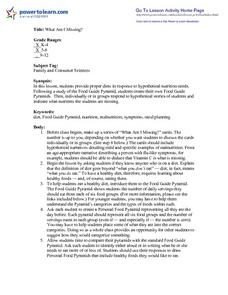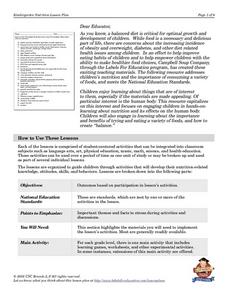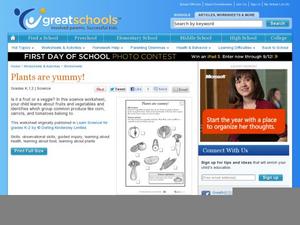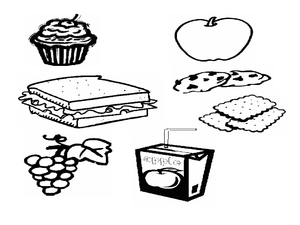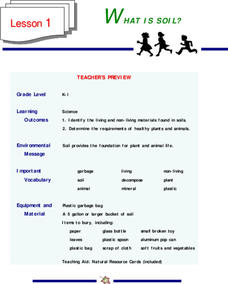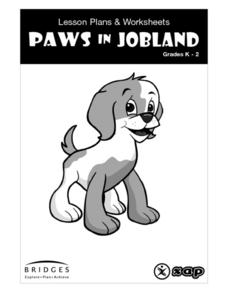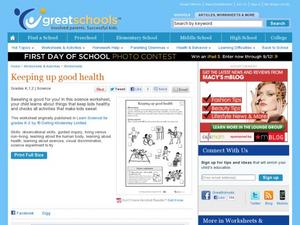Curated OER
What Am I Missing?
Discuss nutrition and identify components of a healthy diet, view a Food Guide Pyramid, and create a Personal Food Pyramid, listing all foods eaten in the past 24 hours. Compare food lists with the standard Food Guide and determine where...
Curated OER
Healthy Heart
Students discover the power of their heart and provide an opportunity to talk about ways to maintain good health. In this early childhood heart activity, students diagram a human heart, identify exercises that promote a healthy heart,...
Curated OER
The ABC's of Breakfast
Students identify the food group of various culturally diverse breakfast foods and discuss the importance of eating a healthy, well-balanced breakfast every morning. They then try different foods that begin with the letter A, B and C and...
Curated OER
Plants are yummy!
Is it a fruit or a vegetable? Youngsters place an F next to each fruit they see and a V next to the vegetables. Corn is tricky. It is a grass, so it's actually not a fruit or a vegetable, but a grain!
Curated OER
Be Kind to Your Teeth
What kinds of food can be bad for your teeth? Kindergartners and first graders explore dental health with an interactive science inquiry. Given a choice of foods such as celery, cake, and milk, kids choose which ones are better for their...
Curated OER
Making Healthy Food Choices
Students examine importance of making healthy food choices, discuss connection between what we eat and healthy body and heart, discriminate between healthy food or "heart-smart choices," and "junk food," and plan healthy meal or snack.
Curated OER
Thank You For the Food We Eat
Learners explore where our food comes from. In this science instructional activity, students discuss how much of our food comes from animals. Learners construct a mobile.
Curated OER
Engineering and the Senses
Students explore nutrition. In this nutrition lesson, students discuss a person's sense of taste and how it is different for each person. Students discuss favorite foods and how they relate to nutrition. Students cut out pictures of...
Curated OER
Favorite Foods
Students explore human health by reading agricultural books. In this dietary habit lesson plan, students discuss the foods we eat everyday and read two books about our human diets. Students identify the uses our body has for food and...
Curated OER
Promoting Daily Fitness; Mini Game
Students evaluate human health by completing an interactive activity on the Internet. In this food choice lesson plan, students identify a list of foods which can make you unhealthy and sick compared to a list of nutritional ingredients....
Curated OER
Feed Me!
When youngsters are learning about the basic needs of humans and animals, this instructional activity could come in handy. In it, pupils circle the pictures of a living thing that is eating food. There are eight pictures all in all, and...
Curated OER
What is Energy?
Youngsters take a look at the foods they eat, and how they provide energy for them to do things. They look at how body uses the food energy to create movement. Pupils also look at toys/devices in the room that need electrical energy...
Curated OER
What is Soil?
Students study living and non-living materials that are found in soil. They study the things required by plants and animals to remain healthy. They design a collage of sand, stones, leaves and other natural items.
Produce for Better Health Foundation
From Grapes to Raisins
How do you make raisins? Do a simple experiment with your class that prompts them to set a bunch of grapes in the sun for a few days, and see what they find!
Curated OER
Good Health Habits
Students examine how they have changed. In this health lesson plan, students use pictures of themselves from babyhood to present to show how they have changed and the teacher relates the importance of healthy habits in growing.
Curated OER
Healthy Heart
Students examine the functions of the heart and ways to maintain a healthy heart. In this human body science instructional activity, students listen to Magic School Bus Inside the Human Heart, and diagram the human heart and blood...
Curated OER
Keeping Up Good Health
During a discussion on sweating with your little ones, this resource should come in handy. Little learners place a check mark next to an activity pictured on the learning exercise that would induce sweating. There are seven pictures to...
Curated OER
Venus Flytrap
Students study the Venus Flytrap including its habitat and how it eats. In this ecology lesson students complete several experiments using a Venus Flytrap to see how it reacts to various conditions.
US Apple Association
Apples: A Class Act! (Grades Pre-K–3)
Discover the nutritional wonders of apples and get to know Johnny Appleseed with a plethora of learning experiences that cover subjects math, history, English language arts, health, and arts and crafts. Activities include an apple...
Curated OER
Washing Germs Away
Students investigate germs. In this cross curriculum health and biology instructional activity, students listen to Old Black Fly by Jim Aylesworth and identify ways in which flies spread germs. Students discuss hand washing during a...
Curated OER
Characteristics of Materials
Students describe and compare common properties of various classroom materials. For this science/matter lesson, students observe common classroom items and the materials they are made of to complete a list of common properties.
Curated OER
Health and Growth
Students recognize that living things need food and water. In this health and growth lesson, students identify foods that are better for health and growth. Students sing a song and complete a worksheet. Students understand that...
Curated OER
Is it alive?
Kids in grades K-2 increase their logical reasoning and visual discrimination skills by determining which things shown are alive. They use the criteria that all living things move on their own to mark each image as alive or not.
Curated OER
Being Alive
Young biologists use a activity to fill in the blanks of five sentences. Each one needs a word from a word band at the top of the resource. All of the sentences are about things that are alive, and how we know they are alive. The words...
